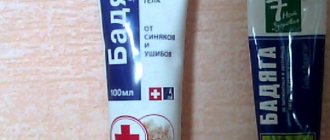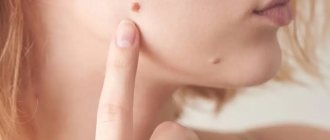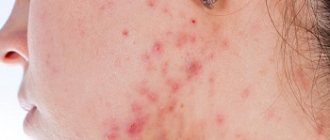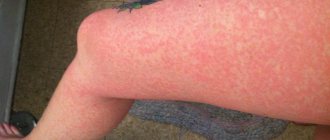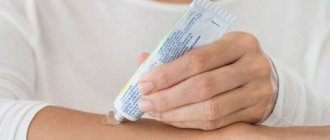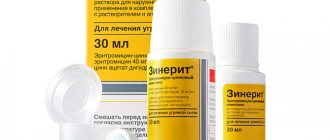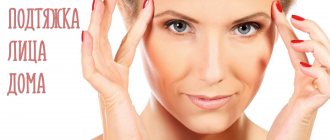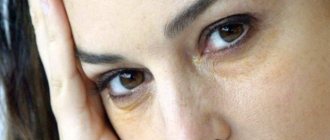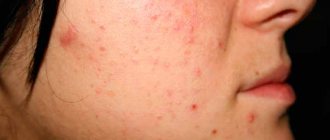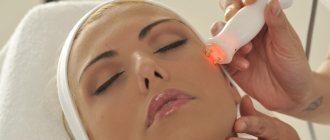Causes of allergies and types of rashes
There are many causes of allergies, the main ones being:
- food products (chicken protein, fish, seafood, cow's milk, citrus fruits, chocolate, nuts and many others);
- chemical detergents and cleaners;
- medications;
- household dust;
- pets (their fur, fluff, saliva);
- insect bites;
- helminth infestations (parasitic worms provoke allergic reactions in humans);
- environmental factors - cold, frost, sun;
- physical procedures associated with current (the cause of a rare form of allergy to physical activity and current).
Allergies often manifest themselves in the form of red, scaly spots that can be located on any part of the body surface.
Main types of rashes:
- Urticaria: rashes in the form of blisters, often multiple, can be located on any part of the body. Accompanied by redness, itching, local swelling. They usually go away within a day. Quincke's edema (swelling of the deep layers of the dermis and subcutaneous fatty tissue) of the upper respiratory tract often develops along with urticaria.
- Atopic dermatitis: The rash in adults is usually localized on the flexor surfaces of the arms and legs, on the back of the neck and behind the ears. The lesions are accompanied by redness, itching, and crust formation.
- Contact dermatitis: the cause is direct contact of the allergen with the skin, therefore it mainly occurs on the hands. The affected area exhibits hyperemia, weeping, swelling, and itching.
- Eczema can be localized on any part of the body, but most often it is the face and hands. It presents as hyperemic areas of the skin with severe swelling and multiple blisters.
What to do if the rashes do not go away
To eliminate long-term skin allergies, you need to choose several ointments. The first group should be intended to relieve itching and swelling, the second for the regeneration of skin cells and to prevent microbial infection.
Elimination of itching and inflammation is achieved using glucocorticosteroids; it must be remembered that such drugs are used only with a doctor’s prescription and in short courses.
This rule especially applies to the treatment of skin allergies in young children. Hormonal ointments include Hydrocortisone, Sinaflan, Advantan, Fluorocort, Elokom.
In pharmacies you can also find modern antihistamine external agents that do not contain hormones, but nevertheless have a good therapeutic effect.
Rules for using hormonal ointments:
- Before use, be sure to consult your doctor. All drugs have contraindications and restrictions for use.
- Follow the dosage and frequency of application exactly. If exceeded, adverse reactions quickly develop
- Use hormonal ointments if necessary. There are safer means.
- Possible side effects from hormonal ointments, especially with long-term use - skin atrophy, the appearance of pustules against the background of reduced immunity, increased blood glucose, decreased adrenal gland performance, stretch marks, baldness, fungal infection. If they appear, consult your doctor immediately.
- Avoid contact with eyes and other mucous membranes. Rinse with plenty of water and if discomfort persists, visit a doctor.
- When applying, lubricate only the affected area, avoiding healthy skin. Otherwise, the opposite effect is possible in the form of skin redness and swelling.
- .The ointment requires gradual withdrawal. Do not suddenly stop using it - side effects and worsening of the underlying disease are possible.
Children's drugs
Antihistamines in drops and ointments for children have a special composition and a minimum number of contraindications. Children's antiallergy creams include Elidel, Desitin and Protopic.
Elidel is a drug used to treat skin rashes of unknown etiology. The main disadvantage of this cream is that after using it, the skin should not be exposed to sunlight.
Disitin is based on zinc oxide. The advantage of the cream is that it practically does not cause side effects, so it can even be used to treat newborns. Please note that before applying Disitin, all inflamed ulcers should be healed.
An analogue of Elidel is Protopic. It can be used to treat children over two years of age. Unlike hormonal creams, this one does not cause addiction and atrophy of the epidermis.
Non-hormonal ointments
Non-hormonal ointments for adults for skin allergies have a mild, gentle effect; there is no systemic effect on the body.
Non-hormonal drugs will not cope with severe and chronic types of allergic dermatoses.
Psilo-balm (diphenhydramine)
Apply 2-3 g to the affected areas 3-4 times a day. Action: antihistamine, antipruritic, local anesthetic, cooling.
Indications: itching and irritation of the skin due to allergic dermatitis, insect bites.
During pregnancy: allowed as prescribed by a doctor. Use during lactation is undesirable.
Average price: 267 rub.
Fenistil (dimetindene)
Application: topically 2-4 times a day. After applying to large areas, avoid direct sunlight. Action: antipruritic, antiallergic, decongestant, antihistamine.
Indications: skin itching due to allergic dermatoses, insect bites.
Pregnancy: 1st trimester – permissible as prescribed by a doctor. II-III trimesters and lactation period - do not use for the treatment of extensive foci of allergies.
Average price: 362 rub.
Protopic (tacrolimus)
Treatment begins with 0.1% ointment, which is applied 2 times a day. If improvement occurs, you can reduce the frequency of application or switch to a 0.03% ointment dosage. Suitable for both short-term and long-term use. Can be used on the face, except eyes and mucous membranes.
Action: anti-inflammatory.
Indications: atopic dermatitis (moderate and severe forms) when other ointments against allergies are ineffective.
Pregnancy: contraindicated.
Average price: 678 rub.
Soventol (bamipin)
Apply a thin layer to the affected area; re-application is possible after 30 minutes.
Action: antipruritic, antiallergic.
Indications: allergic itching (urticaria, insect bites, eczema and other allergic skin manifestations), minor burns and frostbite.
Pregnancy and lactation: with caution.
Average price: 1010 rub.
Elidel (pimecrolimus)
Application: 2 times a day with an interval of 12 hours. Suitable for long-term use. Can be applied to the face, except eyes and mucous membranes.
Action: anti-inflammatory.
Indications: atopic dermatitis.
Pregnancy: with caution.
Average price: 986 rub.
Zinc ointment (zinc oxide)
Application 2-3 times a day. Can be applied to the face except eyes.
Action: anti-inflammatory, disinfecting, drying.
Indications: allergic dermatitis and eczema.
Pregnancy: no restrictions.
Average price: 36 rub.
Treatment of allergies in children over one year of age on the face
At the age of over 1 year, the list of drugs and methods for treating facial allergies expands, but all remedies should also be used with extreme caution and only as prescribed by a pediatrician, so as not to harm the fragile child’s health.
Drug therapy
Treatment is divided into systemic, aimed at eliminating symptoms throughout the body, and local, which is aimed at skin manifestations of allergies.
Hormonal ointments
Hormonal ointments are prescribed for severe allergies and a high risk of complications.
Examples of drugs are given below:
- Hydrocortisone - used for treatment up to 2 times a day, the average course duration is 6 days. The ointment is intended for the treatment of children over 2 years of age; when used in childhood, applying bandages is prohibited. The cost is from 35 rubles ;
- Elokom - in the form of a cream is used to treat children over 2 years old, ointment - over 3 years old. Treatment is carried out once a day, the duration of the course is determined individually by the pediatrician, usually minimum terms are prescribed. You can purchase the drug in pharmacies for a price starting from 180 rubles .
Hydrocortisone
Elokom
Non-hormonal ointments, creams, gels
Non-hormonal preparations for external use can reduce the severity of inflammation and eliminate the main symptoms of allergies on the face.
Below are the remedies that can be used to treat children over one year of age:
- Protopic 0.03% - used for children over 2 years old, the drug is considered the most effective non-hormonal remedy for the treatment of childhood facial allergies. The main advantages are a low risk of side effects and no changes in the upper layers of the epidermis during treatment. Application is carried out 1-2 times a day, course duration is up to 20 days. You can purchase it at a price of 950 rubles ;
- Desitin - is an ointment containing zinc oxide; its use is possible at any age. The drug is not used in the presence of infectious lesions; in other cases, facial treatment is carried out 3 to 5 times a day. It is not recommended to take a course longer than 2-3 weeks. The cost is 250-300 rubles .
Protopic 0.03%
Desitin
Preparations for internal use
Below are various forms of facial allergy medications for internal use that can be used in the treatment of children over one year of age:
- Erius - in the form of syrup is prescribed to children from 1 year old; over the age of 2 years you can switch to tablet form. The daily dosage is 2.5 ml, taken regardless of the diet schedule; The duration of the course is individual and agreed with the pediatrician. You can purchase it at a price of 650 rubles ;
- Diphenhydramine - prescribed when external agents for the treatment of allergies on the face are insufficiently effective. The maximum daily dosage is 75 mg, 3 doses per day, with a break of at least 6 hours between them. The duration of treatment is determined individually, the cost in pharmacies is from 15 rubles .
Erius
Diphenhydramine
Therapy with folk remedies
There are traditional medicine methods that can be used to treat facial allergies in children over one year of age.
Some of them are discussed below:
- Bathing in baths with the addition of sage in childhood can help cope not only with rashes on the face, but also with any other manifestations of allergies. The procedure is carried out 2-3 times a week, the course duration can be 3-4 weeks;
- Raspberry roots - 50 grams mixed with 0.5 liters of water. Place the container on the fire, bring the water to a boil, and cook the broth for another 40 minutes. The resulting decoction should stand for a while, let it cool to the optimal temperature, and then take it orally 2 times a day. The daily dosage is 50 ml, this treatment must be continued until the signs of allergy on the face are completely eliminated;
- Rubbing the affected areas of the face with a slice of potato or cucumber up to 5-7 times a day will help reduce the severity of allergies in a child in just a few days.
Hormonal drugs
Most effective for treating allergic red spots.
They are divided into 4 classes.
| Class | Effect | Drugs |
| I | They have a short-term effect and slowly penetrate the skin. | "Hydrocortisone" |
| II | They have a moderate effect on inflammatory skin processes, the effect is also quite slow. | "Prednisolone", "Desoxymethasone", "Lorinden", "Afloderm" |
| III | Quickly and effectively relieve inflammation, itching, and irritation. | "Elokom", "Celestoderm", "Sinaflamm", "Apulein" |
| IV | They penetrate deeply and quickly into cells and have a powerful anti-inflammatory and anti-allergic effect. | "Galcinonide", "Dermovate" |
Despite their high effectiveness, hormonal drugs can cause serious side effects, especially with long-term treatment.
Hormonal ointments rarely cause systemic complications such as diabetes, weight gain, and menstrual irregularities. This is possible either with increased sensitivity to the drug, or with a significant excess of the daily dosage. Most often, complications are local in nature and are manifested by fungal infection of the area where the ointment is applied.
Victoria Druzhikina
Neurologist, Therapist
Most hormonal ointments have a very similar mechanism of action and main indications, so you can combine them:
- Action: anti-inflammatory, antipruritic, antiallergic, decongestant.
- Indications: eczema, neurodermatitis, atopic dermatitis and other allergic dermatitis.
- Pregnancy and lactation: use only when absolutely necessary as prescribed by a doctor for short-term courses. During lactation, do not apply to the mammary glands.
Hydrocortisone
Quickly helps relieve itching and swelling. Penetrates deep into tissues and, with prolonged use, has a systemic effect. The effect lasts no more than 4 hours, so it requires 2-3 applications. Price – 35 rubles.
Prednisolone
Antiallergic, antipruritic, anti-inflammatory effect occurs quickly, works longer - up to 8 hours, applied 1-2, less than 3 times a day for 1-2 weeks. With prolonged use, skin atrophy is possible. Price - 30 rubles.
Elokom
The drug is based on mometasone. Apply 1 r/day. Helps with dermatitis and insect bites. The ointment is greasy and stains clothes. Price – 80 rubles
Elokom-S
In addition to mometasone, the composition includes salicylic acid, which dissolves rough scales, softening and cleansing the skin during peeling. Used 2 times a day for atopic, seborrheic dermatitis, psoriasis. The drug cannot be used for herpetic rashes and pustular lesions. Price – 780 rubles.
Advantan
Methylprednisolone drug. Wide spectrum of action. It helps well with insect bites, can be used in children from 4 months. Apply 1 time per day. The duration of use of the ointment is limited to 12 weeks in adults and 4 weeks in children. Price – 500 rubles.
Celestoderm
Active ingredient: betamethasone. It is used in pediatrics from 6 months, but produces side effects such as increased intracranial pressure, increased blood sugar, and adrenal suppression. Duration of use 1-3 times a day, lightly rubbing, duration of treatment up to 4 weeks. Price – 250 rubles.
Doctor's advice
If an allergy occurs, first of all you need to avoid contact with the allergen. Not only cream or ointment is important in treatment, but also following a hypoallergenic diet. Nuts, citruses, chocolate, chicken, cheese, eggs, fish, as well as all yellow, orange or red foods (carrots, beets, tomatoes, yellow apples and pears, watermelons, etc.) are excluded from the diet. This is done regardless of whether you have food intolerances or not. The above products help increase the level of histamine in the blood. Histamine is a chemical that triggers and maintains an allergic reaction. Therefore, it is important to follow a diet for 5-7 days, but if the process continues, then continue to limit your diet. For long-term eczema and dermatitis, each product is introduced gradually, separately from the others, and possible skin reactions are monitored.
Victoria Druzhikina Neurologist, Therapist
Lorinden-S
In addition to the hormone, Flumethasone contains the antiseptic clioquinol, which has an antimicrobial effect, so use is possible for impetigo, infectious dermatitis, as well as when a bacterial infection is associated with another type of dermatitis. Approved for use in pregnant women. Not for skin cancer. Price – 435 rubles.
Sinaflan
Fluocinolone contains acetonide. It also has an anti-edematous, drying effect. No more than 3 times a day; if improvement occurs, reduce the number of applications to 1-2 times a day. The duration of treatment is no more than 2 weeks. For hyperkeratosis, the ointment is used with an occlusive dressing once a day or twice for no more than 1 week. Price – 70 rubles.
Choosing an effective remedy
For any skin rashes caused by allergies, it is recommended not to self-medicate, but to immediately consult a dermatologist.
He will advise you to undergo an examination (take tests) to identify the true cause, and will help you navigate a wide variety of medications. Ointments for skin allergies differ in price and purpose.
High cost is not always an indicator of effectiveness. A positive result largely depends on the purpose of the drug.
Cost of medicines
The modern pharmaceutical market offers many antiallergic ointments, expensive and cheap. The table provides a list of the most effective drugs and their average cost.
| Name | Price | Short description |
| Non-hormonal | ||
| Skin cap | 2000 RUR | An expensive drug of the latest generation, which is highly effective. It is applied to the skin twice a day. It does not cause side effects, but has the greatest effect if the therapeutic course lasts at least four weeks. |
| Zinc | 30 RUR | Inexpensive and effective ointment for allergies. Disadvantage: It dries out the skin a lot. Before application, it is recommended to treat the damaged area of skin with any antiseptic. Can be used during pregnancy. |
| Levomekol | 150 RUR | Designed for outdoor use. It helps well with purulent skin lesions (impregnate a sterile gauze bandage with the product and apply it to the wound). Contraindicated in case of individual intolerance to individual components included in its composition. |
| Bepanten | 500 RUR | It is used as a healing agent and is good for allergies in adults and children. The therapeutic course is stopped after all unpleasant manifestations disappear. It is not recommended to use Bepanten if the patient has a wet type allergy. The cream moisturizes the skin and can cause an exacerbation of the disease. |
| Belosalik | 700 RUR | The drug is often used to treat allergic rashes on the skin of the hands in adults. Apply to the wound every 12 hours. Before use, it is necessary to treat the affected area with an antiseptic. |
| Erythromycin ointment | 140 RUR | It is used to treat diseases of the eyelids and mucous membranes of the eyes, when allergies manifest themselves in the form of purulent lesions and crusts. It is applied only to damaged areas of the skin no more than three times a day. The therapeutic course can last up to two weeks. |
| Fucidin | 600 RUR | The therapeutic course should not last more than ten days. This allergy ointment can be applied in a thin layer no more than three times a day and only on damaged areas. The skin is pre-treated with an antiseptic. |
| Flucinar | 300 RUR | This is an effective antipruritic agent. It works instantly. Apply with light massaging movements no more than twice a day. Therapeutic course – 7 days. For large skin lesions – 2 weeks. |
| Prednisolone | 50 RUR | This allergy ointment is fast-acting, but quite “aggressive”. It is applied to the skin in a thin layer three times a day. The therapeutic course is no more than ten days. |
| Akriderm | 100 RUR | This is a fast-acting antipruritic and anti-inflammatory drug. It can only be used under the supervision of a doctor and no more than three times a day. It is contraindicated in pregnant women. |
| Hormonal | ||
| Advantan | 800 RUR | This is the latest development of scientists. The therapeutic course can last up to 12 weeks (no more than seven weeks if there are rashes on the skin around the eyes), before use you should consult your doctor. The product is applied no more than once a day, only in a thin layer and only on the damaged area. |
| Sinaf | 100 RUR | It helps with skin allergies, but can cause side effects. The ointment is applied only to the damaged area in a thin layer. The therapeutic course should last no more than ten days. If the positive effect occurs quickly, the use of the drug can be reduced to seven days. |
| Comfoderm | 500 RUR | The drug is intended for the treatment of allergic rashes in adults. It acts gently, but can cause adverse reactions if the ointment gets on a healthy area. The therapeutic course can last 3 months (for the skin near the eyes - no longer than 5 days). |
| Elidel | 900 RUR | It is considered a universal ointment, suitable for the treatment of allergic manifestations on the face, neck, and limbs. It is allowed to be applied only to damaged areas of the skin, in a thin layer, rubbing thoroughly. Treatment is stopped after a positive result becomes noticeable. |
Purpose and localization
Depending on what kind of rash (eczema, dermatitis or itching) you have to deal with, there are several groups of allergy ointments. For the skin on the face (near the eyes), arms and legs, you will need different products:
- “Skin-cap”, “Hydrocortisone”, “Prednisolone”, “Advantan” help well with eczema;
- for allergic dermatitis - “Celestoderm”, “Lorinden S”;
- if there is urticaria, the doctor prescribes Elokom;
- get rid of itching with the help of “Beloderma”, “Mesoderm” or “Psilo-balm”.
If allergic rashes appear on the face, Fenistil or Psilo-Balm gel will help. To treat thin skin near the eyes, it is better to use Levomekol, Lorinden, and Hydrocortisone. They relieve swelling and inflammation of the eyelids. If the skin of the legs and arms is affected, doctors prescribe hormonal ointments “Flucinar” or “Advantan”.
Skin allergy gel
Comparison table of ointments
| Name of ointment | Application | Additional effect | Average price (RUB) |
| "Hydrocortisone | For lesions 1-3 times per day. | 32 | |
| "Prednisolone" | 1-3 times a day, course 8-14 days. | 27 | |
| "Elocom" (mometasone) | 1 time per day, the duration of treatment is individual and determined by the doctor. | Good for itching and irritation of the skin. | 370 |
| "Elocom-S" (+ salicylic acid) | 2 times a day, daily dose no more than 15 g. | Gives a keratolytic effect. Helps with allergic dermatitis accompanied by hyperkeratosis (atopic dermatitis, seborrheic dermatitis). Hyperkeratosis is an excessive division of epidermal cells with impaired desquamation, leading to thickening of the skin. | 663 |
| Advantan (methylprednisolone) | 1 r/d. The duration of use should not exceed 12 weeks, and when using an emulsion - 2 weeks. | 550 | |
| "Celestoderm" (betamethasone) | Lightly rubbing 1-3 times a day, treatment duration up to 4 weeks. | 232 | |
| "Lorinden-S" (flumethasone, clioquinol) | No more than 3 times a day; if improvement occurs, reduce the number of applications to 1-2 times a day. The duration of treatment is no more than 2 weeks. For hyperkeratosis, the ointment is used with an occlusive dressing once a day or twice for no more than 1 week. | Plus antimicrobial and antifungal effect. Used for allergic dermatoses with associated bacterial or fungal infection. | 376 |
Children's ointments and creams with healing and regenerating effects
If allergic rashes on the child’s skin become infected due to scratching, treatment must begin with antibacterial therapy. Ointments such as Sulfargin or Dioxidin, as well as old, time-tested drugs - zinc or ichthyol ointment, will help to cope with microbes.
When the acute symptoms of inflammation have been relieved and the allergic rash has almost disappeared, you can consolidate the effect with the help of creams that accelerate cellular regeneration of the skin. Solcoseryl and Actovegin, drugs based on calf blood, have proven themselves well.
Radevit, Videstim, Curiosin and methyluracil ointment will also help increase local immunity and speed up skin healing. And below you will find information about regenerating creams that give the best effect in the final healing of allergic rashes in children.
Bepanten
- Active ingredient: dexpanthenol
- Price range: 250-270 rubles
- Indications: diaper dermatitis, dryness and flaking of the skin in allergic dermatitis and eczema, irritation from rough clothing, cracking from frost
- Side effects: very rarely - itching and urticaria
- Special instructions: there are several analogues of Bepanten, created on the basis of the same active ingredient: D-panthenol, Bepanten Plus. All of these creams are great for treating allergies and skin irritations in children.
La Cree
- Active ingredients: panthenol, bisabolol, avocado and walnut oil, string and licorice extracts
- Price range: 150-170 rubles
- Indications: irritation and peeling of the skin of any etiology, allergic dermatitis, urticaria, itching from insect bites
- Side effects: individual allergic reactions in case of intolerance to plant components
- Special instructions: La-Cri cream is more of a good moisturizing baby cream than a serious medical preparation. It will not cure severe dermatitis, but it will cope well with minor skin irritation.
Mustela Stelatopia
- Active ingredient: bioceramides, fatty acids, sugars, procholesterol, sunflower oil
- Price range: 1000-1200 rubles
- Indications: care for infant skin prone to diaper rash and atopic dermatitis
- Side effects: not registered
- Special instructions: Mustella Stelatopia is a gentle emulsion created specifically for skin care for babies from birth to one year. It is not a medicinal ointment; it is rather a prophylactic agent that prevents the appearance of diaper rash and dermatitis.
Ointments for allergies on the face, including the eye area
| Application | Indications | Average price (RUB) | |
| "Dex-gentamicin" (dexamethasone, gentamicin) | A small amount is placed in the conjunctival sac 1 to 4 times a day. If improvement occurs, gradually reduce the frequency to 1 per day. | Inflammatory eye diseases | 142 |
| "Hydrocortisone" | Injected directly from the tube into the conjunctival sac 1-3 times a day. | Allergic conjunctivitis | 16 |
In some cases, doctors prescribe ointments such as Advantan, Celestoderm-B, and Lorinden-S for allergies on the skin of the face and eye area. These drugs are applied to the eyelids and around the eyes, avoiding contact with the conjunctiva. They should be used very carefully, in short courses, strictly under the supervision of a doctor (the development of glaucoma is possible).
Non-hormonal allergy medications for use on the face (except eyes) include Zinc Ointment, Elidel, and Protopic.
Reviews
Elena, 37 years old To treat allergies you need to choose a good ointment. We always buy Bepanten, and Lorinden C is good for the eyes. The result is visible after 3 days.
Irina, 25 years old Allegard helps me fight allergic itching. It was recommended to me by an allergist from our hospital; the redness and itching go away quite quickly.
Alexander, 43 years old And Allergonix helped me with allergies. The product is very, very high quality, and its price is reasonable. It helped clear up the rashes on my face. I didn't regret using it.
Article on the topic: Rash on the palms (rashes) - signs of the disease, symptoms and treatment
Products suitable for pregnant women
There are quite a few ointments for skin allergies allowed during pregnancy. For most drugs, the instructions indicate that it should be used with caution, only as prescribed by a doctor, and some drugs are completely contraindicated.
But there are drugs that are absolutely safe to use for a baby:
- “Zinc paste” - described above.
- “Bepanten”, “Solcoseryl”, “Panthenol” - do not have a direct anti-allergic effect, but have a regenerating, softening, moisturizing and anti-inflammatory effect.
Here is not a complete list of ointments against skin allergies, but only some popular representatives. It is not recommended to prescribe such medications on your own, especially if you are experiencing the disease for the first time. Only a doctor, after a full examination, will be able to prescribe a full treatment, which will include, among other things, local therapy.
If you still have questions, ask your allergist-immunologist.
This article has been verified by a current qualified physician, Victoria Druzhikina, and can be considered a reliable source of information for site users.
Bibliography
1. https://www.rosminzdrav.ru/documents/9159-poryadok-okazaniya-meditsinskoy-pomoschi-naseleniyu-po-profilyu-allergologiya-i-immunologiya-utv-prikazom-ministerstva-zdravoohraneniya-rossiyskoy-federatsii-ot- 7-noyabrya-2012-g-606n
Rate how helpful this article was
5 37 people voted, average rating 5
Did you like the article? Save it to your wall so you don’t lose it!
How to get rid of allergies?
Using a face cream for allergies is usually the most effective treatment option. The only thing that needs to be taken into account is that the effect on rashes and peeling should be carried out only under the supervision of a specialist.
A face cream prescribed by a doctor against allergies must meet the following characteristics:
- contain moisturizing ingredients;
- eliminate itching and burning;
- quickly relieve signs of irritation on the skin;
- protect the dermis from allergens;
- have an increased effect.
Before using the product, you must make sure that it does not contain substances to which your facial skin may react inadequately. Individual intolerance to some ingredients can lead to dangerous and unpredictable consequences.
Helpful advice! When treating an allergic reaction on the skin, you must follow a few simple rules - completely stop using decorative cosmetics, strictly follow all the requirements set out in the instructions and, if necessary, take pharmaceutical drugs prescribed by a doctor. Only an integrated approach will help you quickly and effectively cleanse your face.
What can cause body allergies in adults and children?
The most common irritants that can trigger an allergic reaction are:
- alcoholic drinks;
- food products, including various flavors and food additives;
- body care products and decorative cosmetics;
- certain types of metals;
- drugs of some groups;
- animal hair;
- clothing made from synthetic materials;
- construction and household dust;
- insect bites.
In the development of an allergic reaction, it is not the contact with the allergen itself that plays an important role, but its quantity and duration of exposure.
Antibiotic ointments
Ointments containing antibiotics are used in the treatment of skin allergies if a secondary infection occurs.
The antibacterial components of such drugs block the proliferation of pathogenic microorganisms, which prevents further spread of infection, eliminates swelling, irritation and promotes tissue restoration.
Levomekol.
Thick white ointment after application to the skin becomes liquid and easily penetrates deep into the tissue. It is recommended to distribute Levomekol on a sterile gauze pad and apply it to the area of inflammation.
The dressings are changed once a day. The ointment remains active even if there is pus and necrotic tissue debris in the wound.
The drug can be used during pregnancy starting from the second trimester.
The total duration of treatment depends on the condition of the source of infection and is determined by the doctor. Side effects when using Levomekol develop extremely rarely.
Erythromycin ointment.
Available in two versions - in the form of skin or eye ointment, they differ in the base, but the concentration of the active substance in both preparations is the same.
Eye ointment is prescribed to eliminate allergic rashes on the eyelids and mucous membranes in the event of the addition of pathogenic bacteria, which may be indicated by increased inflammation and swelling, and the formation of purulent crusts.
You can apply erythromycin ointment to the eyelids and behind the conjunctiva up to three times a day. Before distributing the product, purulent masses are removed with an antiseptic.
The course of therapy with eye ointment is from 5 to 14 days. The drug for the treatment of purulent inflammations on the skin can be used for up to 3 months.
Fucidin.
For external use it is available in the form of ointment and cream. Used in the treatment of allergic skin rashes complicated by secondary infection, up to 3 times a day, applying a thin layer to the inflammation area cleaned with an antiseptic.
The average duration of treatment is 10 days. It is recommended to maintain the same time interval when applying the product.
IMPORTANT: Antibacterial external drugs in the treatment of allergies are used only in complex therapy.
When treating allergies on a child’s skin, any external remedy may not cause a positive effect, but rather a worsening of the condition.
Therefore, upon first use, it is advisable to dilute the selected external product with baby cream. If there is no reaction to such a concentration of the solution, you can already use the ointment in its pure form.
When using the ointment, it is advisable to avoid applying it to the palms and fingers, and not to allow the product to get into the eyes.
POPULAR WITH READERS: Allergy creams and ointments for children, review of popular products
The most popular ointments
Elidel.
The ointment has a pronounced anti-inflammatory effect and relieves itching on the skin. It can be used in children from the age of three and not only to eliminate rashes, but also for the treatment of atopic dermatitis.
Skin - Cap.
It has anti-inflammatory, antimicrobial and antimycotic effects. It removes inflammation and skin irritation well, softening it at the same time.
It is also available in aerosols, the use of which ensures more effective penetration of the product into all affected skin cells.
